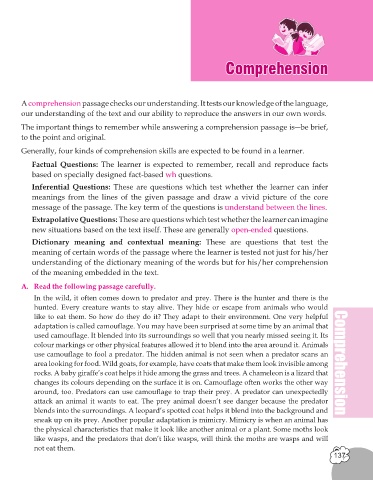Page 139 - English Grammar - 7
P. 139
Comprehension
Comprehension
A comprehension passage checks our understanding. It tests our knowledge of the language,
our understanding of the text and our ability to reproduce the answers in our own words.
The important things to remember while answering a comprehension passage is―be brief,
to the point and original.
Generally, four kinds of comprehension skills are expected to be found in a learner.
Factual Questions: The learner is expected to remember, recall and reproduce facts
based on specially designed fact-based wh questions.
Inferential Questions: These are questions which test whether the learner can infer
meanings from the lines of the given passage and draw a vivid picture of the core
message of the passage. The key term of the questions is understand between the lines.
Extrapolative Questions: These are questions which test whether the learner can imagine
new situations based on the text itself. These are generally open-ended questions.
Dictionary meaning and contextual meaning: These are questions that test the
meaning of certain words of the passage where the learner is tested not just for his/her
understanding of the dictionary meaning of the words but for his/her comprehension
of the meaning embedded in the text.
A. Read the following passage carefully.
In the wild, it often comes down to predator and prey. There is the hunter and there is the
like to eat them. So how do they do it? They adapt to their environment. One very helpful
adaptation is called camouflage. You may have been surprised at some time by an animal that
used camouflage. It blended into its surroundings so well that you nearly missed seeing it. Its
colour markings or other physical features allowed it to blend into the area around it. Animals
use camouflage to fool a predator. The hidden animal is not seen when a predator scans an
area looking for food. Wild goats, for example, have coats that make them look invisible among
rocks. A baby giraffe’s coat helps it hide among the grass and trees. A chameleon is a lizard that
changes its colours depending on the surface it is on. Camouflage often works the other way
around, too. Predators can use camouflage to trap their prey. A predator can unexpectedly
attack an animal it wants to eat. The prey animal doesn’t see danger because the predator
blends into the surroundings. A leopard’s spotted coat helps it blend into the background and
sneak up on its prey. Another popular adaptation is mimicry. Mimicry is when an animal has
hunted. Every creature wants to stay alive. They hide or escape from animals who would Comprehension
the physical characteristics that make it look like another animal or a plant. Some moths look
like wasps, and the predators that don’t like wasps, will think the moths are wasps and will
not eat them.
137

